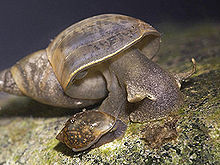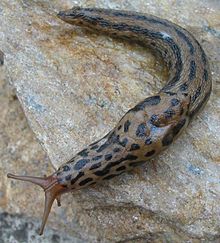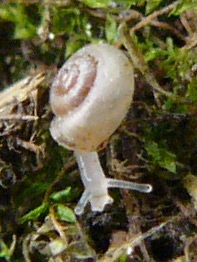
The non-marine mollusks of Montana — a part of the molluscan fauna of the state in the Northwestern United States. The non-marine mollusks of Montana consist of land snails and slugs as well as freshwater snails, freshwater mussels and freshwater clams.
Species
A number of species of non-marine molluscs are found in the wild in Montana.
- Gastropods
There at least 155 species of gastropods found in Montana. [1] Some of these species are exotics (not native to Montana) [2] and some species have been designated as Species of Concern. [3]
- Freshwater bivalves
There are at least 42 species of freshwater bivalves known in Montana. [4] The Montana Department of Fish, Wildlife and Parks has identified a number of bivalve species as Species of Concern. [5]
List of non-marine molluscs
| Numbers of molluscs by habitat | Number of species |
|---|---|
| Freshwater gastropods | ?? |
| Land gastropods | ?? |
| Total number of non-marine gastropods | 155 |
| Freshwater bivalves | 42 |
| Total number of non-marine molluscs | 197 |
Freshwater gastropods
Freshwater gastropods in Montana include: [6]
- Pyrgulopsis bedfordensis
- Fluminicola fuscus
- Probythinella emarginata
- Potamopyrgus antipodarum
- Colligyrus greggi
- Amnicola limosa
- an undescribed species of Amnicola, currently known as "Lake Amnicola" or "Amnicola sp. 1" [9]


- Stagnicola apicina
- Radix auricularia
- Fossaria dalli
- Stagnicola elrodi
- Fossaria obrussa
- Stagnicola elrodiana
- Fossaria humilis
- Stagnicola elodes
- Pseudosuccinea columella
- Stagnicola montanensis
- Fossaria bulimoides
- Fossaria parva
- Fossaria modicella
- Fisherola nuttalli
- Lymnaea stagnalis
- Stagnicola traski
- Stagnicola catascopium
- Stagnicola caperata
- Physella vinosa
- Physa skinneri
- Aplexa elongata
- Physa megalochlamys
- Physa jennessi
- Physella acuta
- Physella virgata
- Physella propinqua
- Physella columbiana
- Physella gyrina
- Physella lordi
- Physella zionis
- Gyraulus parvus
- Menetus opercularis
- Gyraulus circumstriatus
- Planorbella pilsbryi
- Gyraulus deflectus
- Planorbella trivolvis
- Planorbula campestris
- Promenetus exacuous megas
- Planorbella subcrenata
- Promenetus exacuous
- Gyraulus crista
- Planorbula armigera
- Helisoma anceps
- Promenetus umbilicatellus
- Ferrissia rivularis
- Ferrissia fragilis
- Ferrissia parallelus
Land gastropods
Land gastropods in Montana include: [10]
- Catinella rehderi
- Catinella vermeta
- Oxyloma decampi
- Oxyloma gouldi
- Oxyloma haydeni
- Oxyloma missoula
- Oxyloma nuttallianum
- Oxyloma retusum
- Succinea grosvenori

- Arion ater
- Arion circumscriptus
- Arion distinctus
- Arion fasciatus
- Arion intermedius
- Arion rufus
- Arion subfuscus
- Hemphillia camelus
- Hemphillia danielsi
- Kootenaia burkei
- Magnipelta mycophaga
- Prophysaon andersoni
- Prophysaon humile
- Udosarx lyrata - with subspecies: Udosarx lyrata lyrata and Udosarx lyrata russelli
- Zacoleus idahoensis
- Columella columella
- Columella edentula
- Gastrocopta armifera
- Gastrocopta holzingeri
- Gastrocopta pentodon
- Vertigo binneyana
- Vertigo concinnula
- Vertigo cristata
- Vertigo elatior
- Vertigo gouldi
- Vertigo modesta
- Vertigo ovata

- Oreohelix alpina
- Oreohelix amariradix
- Oreohelix carinifera
- Oreohelix elrodi
- Oreohelix haydeni
- Oreohelix pygmaea
- Oreohelix strigosa - with subspecies: Oreohelix strigosa berryi and Oreohelix strigosa depressa
- Oreohelix subrudis
- Oreohelix yavapai - with subspecies: Oreohelix yavapai mariae

- Vallonia albula
- Vallonia costata
- Vallonia cyclophorella
- Vallonia gracilicosta
- Vallonia perspectiva
- Vallonia pulchella
- Zoogenetes harpa
Freshwater bivalves
Freshwater bivalves in Montana include:
- Musculium lacustre
- Musculium partumeium
- Musculium securis
- Musculium transversum
- Pisidium adamsi
- Pisidium arbortivum
- Pisidium casertanum
- Pisidium compressum
- Pisidium conventus
- Pisidium fallax
- Pisidium ferrugineum
- Pisidium idahoense
- Pisidium imbecille
- Pisidium insigne
- Pisidium lilljeborgii
- Pisidium milium
- Pisidium nitidum
- Pisidium obtusale
- Pisidium ovum
- Pisidium roperi
- Pisidium rotundatum
- Pisidium scutulatum
- Pisidium subtruncatum
- Pisidium variabile - with subspecies: Pisidium variabile magnum
- Pisidium ventricosum
- Pisidium walkeri
- Sphaerium fabale
- Sphaerium nitidum
- Sphaerium occidentale
- Sphaerium patella
- Sphaerium rhomboideum
- Sphaerium simile
- Sphaerium striatinum
- Sphaerium sulcatum
- Sphaerium tenue
See also
References
- ^ "Gastropoda". Montana Natural Heritage Program. Retrieved 2011-07-22.
- ^ Exotic species have been deliberately or accidentally introduced to areas outside of their native geographic range and are able to reproduce and maintain sustainable populations in these areas. These exotic populations may also be referred to as alien, introduced, invasive, non-native, or non-indigenous. "Species Status Codes, Exotics". Montana Natural Heritage Project. Retrieved 2011-06-17.
- ^ Species of Concern are native taxa that are at-risk due to declining population trends, threats to their habitats, restricted distribution, and/or other factors. Designation as a Montana Species of Concern or Species of Concern is based on the Montana Status Rank, and is not a statutory or regulatory classification. Rather, these designations provide information that helps resource managers make proactive decisions regarding species conservation and data collection priorities. "Species Status Codes, Species of Concern". Montana Natural Heritage Project. Retrieved 2011-06-17.
- ^ "Montana Field Guide-Bivalvia". Montana Department of Fish, Wildlife and Parks. Retrieved 2010-12-26.
- ^ Species of Concern are native taxa that are at-risk due to declining population trends, threats to their habitats, restricted distribution, and/or other factors. Designation as a Montana Species of Concern or Potential Species of Concern is based on the Montana Status Rank, and is not a statutory or regulatory classification. Rather, these designations provide information that helps resource managers make proactive decisions regarding species conservation and data collection priorities. See the latest Species of Concern Reports for more detailed explanations and assessment criteria. "Montana Field Guide-Species of Concern". Retrieved 2010-12-07.
- ^ "Basommatophora". Montana Nature Heritage Program. Retrieved 2011-07-22.
- ^ "Heterostropha". Montana Nature Heritage Program. Retrieved 2011-07-22.
- ^ "Neotaenioglossa". Montana Nature Heritage Program. Retrieved 2011-07-22.
- ^ "Lake Amnicola — Amnicola sp. 1". Montana Field Guide. Montana Natural Heritage Program. Montana State Government. Retrieved 19 July 2014.
- ^ "Stylommatophora". Montana Nature Heritage Program. Retrieved 2011-07-22.
- ^ "Montana Field Guide-Margaritiferid mussels". Montana Department of Fish, Wildlife and Parks. Retrieved 2012-12-28.
- ^ "Montana Field Guide-Unionid mussels". Montana Department of Fish, Wildlife and Parks. Retrieved 2012-12-28.
- ^ "Montana Field Guide-Fingerclams". Montana Department of Fish, Wildlife and Parks. Retrieved 2012-12-28.
Further reading
- Daniel L. Gustafson. "Aquatic Invertebrates of Montana". Biology Department Montana State University-Bozeman. Retrieved 2011-07-22.
- Henderson, J (1924). Mollusca of Colorado, Utah, Montana, Idaho and Wyoming. Boulder, CO: University of Colorado Museum.
- "Freshwater Mussels of Montana-A Field Guide" (PDF). Montana Natural Heritage Program. Retrieved 2010-12-28.
- Stagliano, David (2010). Freshwater Mussels in Montana: Comprehensive Results from 3 years of SWG Funded Surveys (PDF). Montana Natural Heritage Program.
